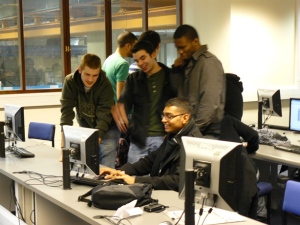Mary Aylmer is a visiting lecturer in the School of Engineering and Mathematical Sciences (SEMS), teaching the CAD part of the module CV1407 IT skills, Communication, and CAD. She has developed an assessment pattern in which students produce five pieces of CAD coursework, each of which involves completing engineering drawings. There are two interim submissions each weighted at 2% of the final module mark, two larger submissions weighted at 16% and 40%, and an end-of-module test also weighted at 40%.
The 2% weighting for the interim submissions is intended to ensure that the students’ early work on the module is taken into account in the final module mark, which helps to focus them to the task. The exercises are carefully graded and enjoyable for the students to complete; they tend to take ownership of their own learning as the assessments are designed such that they are able to determine exactly what is required of them, so they can aspire to high marks.
 The obvious advantage of this assessment pattern is that it ensures that the students are definitely completing their initial work on the module. This means that they are well prepared for the larger submissions: they have already accrued plenty of experience of CAD in the first few weeks through the interim submissions, and are thereby placed in a strong position to tackle the difficult drawings. In other words, it ensures that they undertake the groundwork first.
The obvious advantage of this assessment pattern is that it ensures that the students are definitely completing their initial work on the module. This means that they are well prepared for the larger submissions: they have already accrued plenty of experience of CAD in the first few weeks through the interim submissions, and are thereby placed in a strong position to tackle the difficult drawings. In other words, it ensures that they undertake the groundwork first.
The downside to this system for the tutor is that it generates a substantial amount of marking. Mary has also noted a tendency among students to query their marks, even in the case of the 2% submissions which are unlikely to have a significant impact on their overall degree average. It can become very time-consuming to justify marks deducted, particularly with 120 students each of whom submit 5 pieces of work.
Nonetheless, the outcomes speak for themselves. By the end of the module, the students can produce good CAD drawings fairly easily; and they have indicated through their feedback that they enjoy the course, which is very encouraging. While an assessment model such as this may be time-consuming for the tutor, it is evidently worth the investment if it results in robust learning and student satisfaction.
Christopher Wiley and Mary Aylmer



Leave a Reply